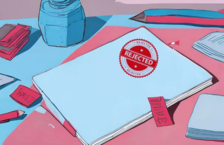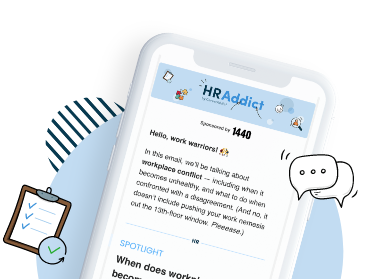When you’re going through the hiring process, it’s important to put yourself in the shoes of the candidate and be as kind as possible.
A jobseeker will most likely spend hours putting their résumé together and crafting their cover letter so that, in their eyes, they perfectly match your job ad, and they will eagerly await a reply — even if it’s just a “thanks but no thanks” kind of thing!
To make sure you don’t turn them off your brand (and potentially give your company a bad reputation in the process), even if you’ve decided not to proceed with their application before they’ve even reached the interview stage, it’s always a good idea to do so gently in the form of a well-written letter.
This simple gesture will show that you appreciate their time, which in turn will make them value your company and it also gives them validation to continue with their job search.
So, without further ado, here’s how to write a rejection letter before an interview.
TABLE OF CONTENTS
What is a pre-interview rejection letter?
A pre-interview rejection letter is a professionally written letter than recruiters and hiring managers send to candidates before they’ve even made it to the interview stage. It notifies them that they haven’t been shortlisted for the position they applied to and that you won’t be progressing with their application.
Although not commonly used (with many employers instead preferring to simply mention in the job description something along the lines of “Only shortlisted candidates will be contacted”), sending a pre-interview rejection has many benefits, including:
- It shows applicants that you respect the time and energy they’ve invested in the application process.
- It protects your organization’s branding, both as an employer and as a service provider.
- It helps you maintain positive relationships with applicants, as they might be more suitable to a future position that you can reach out to them about.
Situations to send a pre-interview rejection letter
There are many situations that call for sending an applicant a rejection letter before even inviting them to an interview. These include:
- The applicant isn’t qualified or doesn’t have the right skill set for the specific job.
- The applicant’s salary expectations do not align with your company’s budget for the position (if you collected this information during the application process).
- The applicant didn’t make a good first impression in a screening phone interview (such as they were rude, apathetic or otherwise unprofessional).
- The applicant doesn’t compare well to other candidates, particularly in terms of experience and expertise.
What to include in a rejection letter
There are five important things you need to mention in your pre-interview rejection letter:
Your appreciation
Perhaps the first thing a rejection letter should include is your appreciation of the applicant for taking the time to apply to the job in the first place. Indeed, it would likely have taken the applicant several hours to customize their résumé to the position and craft a targeted cover letter — not to mention complete the application form, especially if it was a comprehensive one.
The reason of rejection
It’s crucial to let the candidate know exactly why they were rejected. For example, instead of simply telling them they “didn’t make the cut”, let them know the reason they didn’t — like if their skill set is lacking in a particular area.
Do keep your reason brief, though, and try to provide the candidate with constructive feedback and even resources on how they improve their application for future opportunities, whether with your company or elsewhere.
Not only will they appreciate this but they’ll also be more likely to apply for said future opportunities when they’ve developed the right skills and knowledge.
The reason of choosing another candidate
If you’ve already chosen another candidate, it’s a good idea to also mention this in your pre-interview rejection letter — this keeps the applicant from re-applying. Diplomacy, however, is key here, while you may also need to speak to your HR department to ensure that you’re allowed to divulge this information.
For example, if the shortlisted or newly appointed employee was already employed in the company, you could mention that the company prefers to promote internally.
The name of the position
As the candidate will likely have applied to other jobs, whether with your company or a different one, it can be hard to keep track of everything. Likewise, as a recruiter, you will likely be juggling many different applicants for many different positions.
To make sure there’s no misunderstanding, as well as to have a clear record of everything, it’s a good idea to mention the name of the position the candidate is being rejected for.
Positive language
While rejection letters aren’t exactly received with open arms, it’s important to use positive and empowering language when writing one. Indeed, doing so can be good for their perception of the company.
Meanwhile, it’s also crucial that your letter is as straightforward as possible and the messaging is clear. Again, this avoids any potential misunderstandings, while it shows the candidate that you respect them enough to not beat around the bush.
How to structure a rejection letter/email
Even though you’re sending a quick rejection note, it’s still important to follow grammatical and structural rules when it comes to composing your email or letter. By following the below structure, you’ll have a professional letter typed up in minutes:
- Sender’s address:Start your letter with your organization’s full address in the top right-hand corner of the page. If you’re writing an email, skip this step.
- Date:Add the send date a few lines under the letterhead. There’s no need to include this if you’re sending an email.
- Inside address:The candidate’s address should be listed a few lines beneath the date – again, if you’re rejecting them via email, you won’t need to include this information.
- Subject:You don’t have to go to great lengths to change the subject of the email. You can use something simple like: “Job Application — XYZ Company — Role”.
- Salutation: There’s no need to be overly formal here. To make the letter more personal, you could write “Dear Name”.
- Opening paragraph:In the first paragraph, you should express your appreciation for the candidate taking the time to apply for the position.
- Body:This is where you will inform the candidate that they were unsuccessful in getting through to the interview stage.
- Final paragraph:In the final paragraph, you can either encourage the applicate to apply for other positions at a later date or let them know that you will keep their details on file for future opportunities.
- Closing:Your closing line should thank the applicant for their time and wish them luck in their job search.
- Your name and signature: To give your letter or email an official stamp, be sure to close with your full name and signature including your contact information.
Tips to follow
When writing your letter, be sure to keep the following tips in mind:
1. Let them know early on
If you know from the second that you skim over a specific application that they aren’t a good match for the job, it’s best to let them know from the get-go. Even if there’s no other suitable candidate to fall back on in the sea of applications, put them out of their misery and send them a quick rejection email.
2. Provide honest feedback
Don’t give them some fake excuse about how you plan to keep their résumé on file when, really, it’s already in the bin. If you do think they’ll be a good match for another position, let them know. Otherwise, just tell them that they have been unsuccessful.
3. Show some support
Job hunting is hard (you should know; you were there once), so be sure to show some support and make the email positive. You could do this by identifying some of their strengths; this could be offering recognition of their main skill set and encouraging them to keep searching for the right position.
Things to remember
Make sure to keep these pointers in mind when writing a rejection letter:
1. Don’t talk about other candidates
Although it’s easy to compare the applicant to other candidates, refrain from doing so. This doesn’t help them — or yourself. On the contrary, if you say that you’re interviewing “more qualified candidates”, it will just make the rejected candidate feel useless and not good enough, which won’t help their psychology going forward in their job search.
2. Don’t waffle on
You’re not writing a heartfelt letter to an ex, so there’s no need to waffle on about your feelings and reasons — you haven’t even met the person! Instead, keep your note short and sweet and to the point.
3. End on a positive note
Be sure to always end on a positive note and try to avoid saying things like “I’m sorry” and “unfortunately”.
Frequently asked questions
Got more questions about pre-interview rejection letters?
Q: Is it necessary to include a reason?
While there’s no need to provide candidates with a specific reason relating to their rejection, it’s only respectful — and human — to do so. Indeed, it helps the rejected candidate understand the decision and then take steps to make improvements in the areas that you deemed they fell short in.
Q: Should I encourage the candidate to apply for future opportunities?
Yes! While the candidate might not have been suitable for this specific position, they might be a better fit for other vacancies that may become available in the future. Encourage them to regularly check your website, and perhaps even point them into the direction of a suitable vacancy that’s currently available.
Q: Can I just use a template?
There’s nothing stopping you from using an editable template to reject candidates, but it’s advisable to write a tailored rejection letter for each candidate. This ensures you come across as considerate and empathetic, which in turn helps you maintain your employer reputation.
Final thoughts
Although it might seem easier to avoid dishing out some of the rejection pie, it can actually be really damaging if you don’t — remember: word travels fast, and you can end up turning consumers against your brand.
To make sure your business is always operating at the same professional level, follow the above tips and take 10 minutes out of your day to let unsuccessful applicants know you won’t be taking their applications further.
Do you usually write to unsuccessful applicants to let them know? Join in on the conversation below and let us know!
This article is a partial update of an earlier version originally published in 2018.

